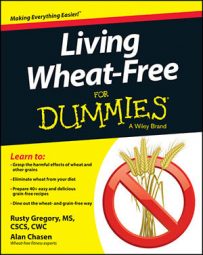So you're ready to make a change in your life by getting rid of wheat in your diet but aren't quite sure how to go about making the change last. Never fear; the change process isn't so dreadful after all. By answering certain questions and discovering what you really want, you can be better equipped to set goals that will propel you into eating a wheat-free, grain-free diet.
Although your primary focus is on eliminating wheat, you might also consider cutting all grains from your diet because they often have similar effects on your body.
Here, you begin to identify the challenges that change presents and figure out where you are in the change process. Learn about the different stages of change and gather the tools necessary to help move forward with each stage. Finally, you can learn how to write effective goals for your new wheat-free lifestyle.
Challenges presented by food
The most obvious challenge in adopting a wheat-free lifestyle is to stop eating the countless foods that contain wheat. Here are the obstacles you have to face:
Food addictions and carbohydrate cravings: The addictive qualities of wheat pose unique challenges for eliminating it from your diet.
Go for a cold-turkey approach when eliminating wheat from your diet. The weaning process prolongs the agony of addictions and cravings and further complicates the removal process.
Incorrect dietary information: You're less likely to commit to a wheat-free diet if you lack the information necessary to change. For several decades, the mandate has been that eating a diet of whole wheat or whole grains is healthy.
MyPlate, the U.S. guidelines for dietary intake, illustrates that you should get the majority of your calories from grains. Educating yourself on the harmful effects of wheat and other grains can help you stay the course of your new lifestyle.
The convenience of the wheat-filled fast-food industry: Lots of fast-food options contain wheat (and not just the buns). The ease and expediency of these wheat-containing foods has created several generations of increased obesity, Type 2 diabetes, heart disease, and cancer.
Other convenience foods outside the fast-food industry are also filled with wheat; from deli meats and veggie patties to salad dressings and fried fish sticks, wheat is prevalent throughout the convenience food market.
The grocery bill: Yes, eating a wheat-free, whole-food diet is more expensive than eating the cheaper grain products you've been buying. No, you don't have to break the bank to eat wheat-free.
Whenever possible, purchase raw ingredients instead of buying prepared foods; raw foods are usually less expensive. Also, certain cuts of meat are cheaper than others. Purchase the more affordable ones so you don't grow to resent your new diet.
Revamp your thoughts and emotions about food
You've probably had the same thoughts and beliefs about food for most of your life. Changing your mindset toward food — especially when you're eliminating something that feels like a staple in your diet — is tough, no doubt about it. Here are some ways to overcome the mental and emotional challenges that come with going wheat-free:
Set goals. Your vision and goals are the skeletal system of the change process. Without these key components, your plan has no structure.
Be confident. If you believe that you can accomplish a goal, you're more likely to work harder at it.
Several ways to increase your confidence include recalling past successful experiences and the strengths they required, setting easily obtainable goals, and identifying strategies to help you get what you want.
Take control of your food and lifestyle choices. What you choose to eat is your decision. Period. Consciously making wheat-free choices may not always be easy, especially when doing so goes against what you're used to, but it's a key to your success.
Food choices are only part of a healthy lifestyle. Running yourself ragged, not getting enough sleep, and stressing out aren't conducive to your new way of living. Remove the clutter and drama from your life so you can make room for big, healthy changes.
Deal with your emotional eating habits. Lots of people are emotional eaters; they eat to celebrate happiness, calm anger or stress, and soothe sadness. The stronger the emotion, the more profound the effect. And many foods people turn to for emotional eating contain wheat.
If you don't acknowledge your emotions and how they can direct your behavior, you're missing out on the powerful influence they have on your ability to change. Identifying what you're emotionally feeling and meeting those needs in a healthier way helps you fight the temptation to be emotional eaters.
Evaluate your readiness and willingness to change. Removing wheat and other grains from your diet is a huge endeavor; it's one well worth it, but if you feel you can't put in the time or effort necessary right now, you may need to examine whether this is the right time to make such a fundamental change in your life.
If it isn't, decide when will be. (When in the short-term future; deciding to fit going wheat-free into your five-year plan isn't going to improve your lifestyle.)

